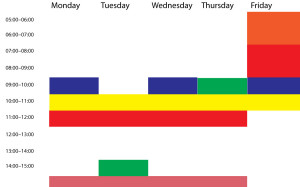I’ve said this before: I now cannot imagine staying in bed later than 5am – but I can’t half dream about it. It turns out that 5am is my best writing time and I hate it. But I do it. And I’ve had countless discussions with people who tend to claim that the best writers get up early (if they like me) or that the best writers work overnight (if they don’t). But now there are facts.
Sort of.
Brain Pickings did a gorgeous thing of trying to work out the unworkable-outable and somehow calculate/divine/guess (*delete as applicable) how early or late the best writers did their thing. They’re open about how you can’t really compare writers and they are frank about how you can’t trust writers anyway, they could all be lying. But as a point of comparison, it’s interesting. And moreover, it’s resulted in some rather beautiful graphics:
The end result — a labor of love months in the making — is this magnificent visualization of the correlation between writers’ wake-up times, displayed in clock-like fashion around each portrait, and their literary productivity, depicted as different-colored “auras” for each of the major awards and stack-bars for number of works published, color-coded for genre. The writers are ordered according to a “timeline” of earliest to latest wake-up times, beginning with Balzac’s insomniac 1 A.M. and ending with Bukowski’s bohemian noon.
Read Maria Popova’s Famous Writers’ Sleep Habits vs. Literary Productivity, Visualized on Brain Pickings.

